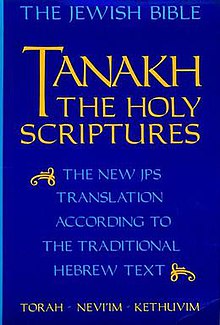New Jewish Publication Society of America Tanakh
The New Jewish Publication Society of America Tanakh, first published in complete form in 1985, is a modern Jewish 'written from scratch'
This translation emerged from the collaborative efforts of an
History
The New Jewish Publication Society translation of the

The translation follows the
The order of the books is as found in published
The editor in chief of the Torah was
The Five Megilloth (Five Scrolls) and Jonah appeared in 1969, the Book of Isaiah in 1973 and the Book of Jeremiah in 1974. Revised versions of Isaiah, Jeremiah and Jonah appeared in Nevi'im (1978), edited by Professor Ginsberg assisted by Professor Orlinsky.
A separate committee was set up in 1966 to translate
Since 2017, the bilingual Hebrew-English edition of the JPS Tanakh (1985 translation) has been digitalized and is available online for free on the website Sefaria.[3]
Revisions
- The first one-volume edition of the NJPS translation of the entire Hebrew Bible was published in 1985 under the title Tanakh. It incorporates a thorough revision of the translation's sections previously issued individually.
- A third edition of The Torah (the first section of the NJPS Tanakh) was published in 1992.
- A bilingual Hebrew-English edition of the full Masoretic Hebrew text as found in the Leningrad Codex.
- The recent series of JPS Bible commentaries all use the NJPS translation.
- The ISBN 0-19-529754-7
- The Contemporary Torah: A Gender-Sensitive Adaptation of the JPS Translation,imagery.
Adoption by Jewish denominations
The NJPS is the basis of the translation used in the official Torah commentaries of both
- The Torah: A Modern Commentary, the Humash published by the Reform Movementin 1974–1980, with a one-volume edition in 1981, includes the NJPS translation.
- A revised edition of this work was issued in 2005, which includes a version of the NJPS translation for the books of Deuteronomy, newly adapted for gender accuracy. (The translations of Genesis, and the prophetic books in this edition, come from a different source.)
- "Humash published by the Conservative Movementin 2001, incorporates the NJPS translation (with minor modifications).
All of these
Usage
- The JPS Torah Translation and excerpts from Prophets is used in The Torah: A Modern Commentary, the Commentary of the Reform Movement.
- The JPS Torah Translation, excerpts from Prophets, and an edited version of its 5-volume Torah and 1-volume Haftorah Commentaries are used in the Etz Hayim, the Commentary of the Conservative Movement.
- The JPS TANAKH Translation is used in the Oxford University Press Jewish Study Bible.
- The JPS TANAKH has been selected as the official Bible for the International Bible Contest.
- The JPS TANAKH has been selected as the official Jewish version to be used in its “Bible as Literature” curriculum for American public schoolsas well as its Jewish Bible website.
- The JPS TANAKH was selected by Quality Paperback Book Clubfor its “Old Testament” edition in its 5-volume Sacred Writings Series.
References
- ^ Chaim Potok (October 3, 1982). "The Bible's Inspired Art". The New York Times.
Song of Songs ... was entirely profane .. could not have been written by Solomon
- ^ a b c Sarna, Jonathan (27 January 2013). "The Jewish Translation That Rewrote the Bible". The Forward. New York. Retrieved 14 January 2019.
- ^ "JPS Bible Translation Enters Digital Era with Sefaria". Jewish Publication Society. 11 May 2017. Retrieved 7 January 2019.
- ^ https://jps.org/the-jps-tanakh-gender-sensitive-edition/
External links
- Tanakh (Hebrew-English), online full text of the bilingual JPS Tanakh (1985) on Sefaria
